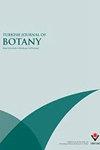青铜器时代土耳其地中海南部农产品的考古植物证据,来自tatarlylHöyük
IF 1.5
4区 生物学
Q3 PLANT SCIENCES
引用次数: 1
摘要
在本研究中,对2011-2012年阿达纳省杰伊汉地区出土的鞑靼斯坦Höyük早、中、晚青铜时代(公元前2400-1200年)的考古植物学数据进行了评估。在与这些时期相关的8条沟中,通过干湿筛分方法,回收了内部区域、壁炉、烤箱、墓穴、陶罐等考古背景,以及碳化植物遗骸的背景,共对应了90个土壤样品。鉴定出的主要农业植物是小麦(Triticum monococum)、小麦(Triticum dicoccum)、面包小麦(Triticum aestivum)、大麦(Hordeum vulgare)和扁豆(Lens culinaris)。已鉴定的野生葡萄树(Vitis sylvestris)、葡萄树(Vitis vinifera)和橄榄树(Olea europaea)表明,在这些时期进行了水果种植,并相应地进行了葡萄酒和橄榄油的生产。考古植物学数据揭示了不同青铜时代栽培物种的变化,显示了在不同时期哪种物种更受青睐,以及气候的变化是否影响了这些偏好。本文章由计算机程序翻译,如有差异,请以英文原文为准。
Archaeobotanical evidence of agricultural products in the southern Mediterranean part of Turkey during the Bronze Ages from Tatarlı Höyük
: In this study, archaeobotanical data were gathered from the Early, Middle, and Late Bronze Age layers (2400–1200 BC) of the Tatarlı Höyük exposed in the 2011–2012 excavation seasons in the Ceyhan district of Adana Province were evaluated. In 8 trenches relating to these periods, archaeological contexts such as inside areas, hearths, ovens, middens, ceramic pots, etc., as well as contexts with carbonized plant remains were recovered by using dry and wet sieving methods, corresponding in total to 90 soil samples. The major agricultural plants identified were Triticum monococcum (einkorn wheat), Triticum dicoccum (emmer wheat), Triticum aestivum (bread wheat), Hordeum vulgare (barley), and Lens culinaris (lentil) species. Identified Vitis sylvestris (wild vine), Vitis vinifera (vine), and Olea europaea (olive) species show that fruit cultivation and accordingly wine and olive oil production were carried out during these periods. Archaeobotanical data revealed the changes in the cultivated species during the different Bronze Ages, showing which species were preferred in different periods and whether changes in the climate affected those preferences.
求助全文
通过发布文献求助,成功后即可免费获取论文全文。
去求助
来源期刊

Turkish Journal of Botany
PLANT SCIENCES-
CiteScore
2.90
自引率
5.60%
发文量
31
审稿时长
6-12 weeks
期刊介绍:
The Turkish Journal of Botany is published electronically 6 times a year by the Scientific and Technological Research Council of Turkey (TÜBİTAK) and accepts manuscripts (in English) covering all areas of plant biology (including genetics, evolution, systematics, structure, function, development, diversity, conservation biology, biogeography, paleobotany, ontogeny, functional morphology, ecology, reproductive biology, and pollination biology), all levels of organisation (molecular to ecosystem), and all plant groups and allied organisms (algae, fungi, and lichens). Authors are required to frame their research questions and discuss their results in terms of major questions in plant biology. In general, papers that are too narrowly focused, purely descriptive, or broad surveys, or that contain only preliminary data or natural history, will not be considered (*).
The following types of article will be considered:
1. Research articles: Original research in various fields of botany will be evaluated as research articles.
2. Research notes: These include articles such as preliminary notes on a study or manuscripts on the morphological, anatomical, cytological, physiological, biochemical, and other properties of plant, algae, lichen and fungi species.
3. Reviews: Reviews of recent developments, improvements, discoveries, and ideas in various fields of botany.
4. Letters to the editor: These include opinions, comments relating to the publishing policy of the Turkish Journal of Botany, news, and suggestions. Letters should not exceed one journal page.
(*) 1. Raw floristic lists (of algae, lichens, fungi, or plants), species descriptions, chorological studies, and plant sociology studies without any additional independent approaches.
2. Comparative morphology and anatomy studies (that do not cover a family, tribe, subtribe, genus, subgenus, section, subsection, or species complexes with taxonomical problems) without one or more independent additional approaches such as phylogenetical, micromorphological, chromosomal and anatomical analyses.
3. Revisions of family, tribe, genus, subgenus, section, subsection, or species complexes without any original outputs such as taxonomical status changes, IUCN categories, and phenological and ecological analyses.
4. New taxa of all plants without any additional independent approaches such as phylogenetical, ecological, chromosomal, chorological and correlational analyses in addition to a detailed macro- and micro-morphological descriptions with quality field and microscopic illustrations of taxonomically important structures and identification key in the taxonomic group.
New records of all plants without any additional independent approaches such as phylogenetical, ecological, chromosomal, chorological and correlational analyses in addition to a detailed macro- and micro-morphological descriptions with quality field and microscopic illustrations of taxonomically important structures and identification key in the taxonomic group may be accepted for peer review if they contain 3 or more new records or taxonomical status update, such as lectotypification, new combinations, transfers, revivals and synonyms.
5. New taxa of algae, lichens, and fungi without any additional independent approaches such as phylogenetical, ecological, chromosomal, chorological and correlational analyses in addition to a detailed macro- and micro-morphological descriptions with quality field and microscopic illustrations of taxonomically important structures and identification key in the taxonomic group.
New records of algae, lichens, and fungi without any additional independent approaches such as phylogenetical, ecological, chromosomal, chorological and correlational analyses in addition to a detailed macro- and micro-morphological descriptions with quality field and microscopic illustrations of taxonomically important structures and identification key in the taxonomic group may be accepted for peer review if they contain 5 or more new records or taxonomical status update, such as lectotypification, new combinations, transfers, revivals and synonyms.
 求助内容:
求助内容: 应助结果提醒方式:
应助结果提醒方式:


